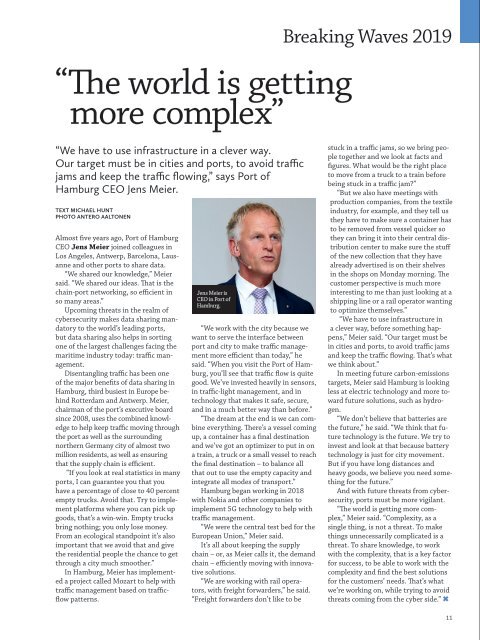You also want an ePaper? Increase the reach of your titles
YUMPU automatically turns print PDFs into web optimized ePapers that Google loves.
“The world is getting<br />
more complex”<br />
Breaking Waves 2019<br />
“We have to use infrastructure in a clever way.<br />
Our target must be in cities and ports, to avoid traffic<br />
jams and keep the traffic flowing,” says Port of<br />
Hamburg CEO Jens Meier.<br />
TEXT MICHAEL HUNT<br />
PHOTO ANTERO AALTONEN<br />
Almost five years ago, Port of Hamburg<br />
CEO Jens Meier joined colleagues in<br />
Los Angeles, Antwerp, Barcelona, Lausanne<br />
and other ports to share data.<br />
“We shared our knowledge,” Meier<br />
said. “We shared our ideas. That is the<br />
chain-port networking, so efficient in<br />
so many areas.”<br />
Upcoming threats in the realm of<br />
cybersecurity makes data sharing mandatory<br />
to the world’s leading ports,<br />
but data sharing also helps in sorting<br />
one of the largest challenges facing the<br />
maritime industry today: traffic management.<br />
Disentangling traffic has been one<br />
of the major benefits of data sharing in<br />
Hamburg, third busiest in Europe behind<br />
Rotterdam and Antwerp. Meier,<br />
chairman of the port’s executive board<br />
since 2008, uses the combined knowledge<br />
to help keep traffic moving through<br />
the port as well as the surrounding<br />
northern Germany city of almost two<br />
million residents, as well as ensuring<br />
that the supply chain is efficient.<br />
“If you look at real statistics in many<br />
ports, I can guarantee you that you<br />
have a percentage of close to 40 percent<br />
empty trucks. Avoid that. Try to implement<br />
platforms where you can pick up<br />
goods, that’s a win-win. Empty trucks<br />
bring nothing; you only lose money.<br />
From an ecological standpoint it’s also<br />
important that we avoid that and give<br />
the residential people the chance to get<br />
through a city much smoother.”<br />
In Hamburg, Meier has implemented<br />
a project called Mozart to help with<br />
traffic management based on trafficflow<br />
patterns.<br />
Jens Meier is<br />
CEO in Port of<br />
Hamburg.<br />
“We work with the city because we<br />
want to serve the interface between<br />
port and city to make traffic management<br />
more efficient than today,” he<br />
said. “When you visit the Port of Hamburg,<br />
you’ll see that traffic flow is quite<br />
good. We’ve invested heavily in sensors,<br />
in traffic-light management, and in<br />
technology that makes it safe, secure,<br />
and in a much better way than before.”<br />
“The dream at the end is we can combine<br />
everything. There’s a vessel coming<br />
up, a container has a final destination<br />
and we’ve got an optimizer to put in on<br />
a train, a truck or a small vessel to reach<br />
the final destination – to balance all<br />
that out to use the empty capacity and<br />
integrate all modes of transport.”<br />
Hamburg began working in 2018<br />
with Nokia and other companies to<br />
implement 5G technology to help with<br />
traffic management.<br />
“We were the central test bed for the<br />
European Union,” Meier said.<br />
It’s all about keeping the supply<br />
chain – or, as Meier calls it, the demand<br />
chain – efficiently moving with innovative<br />
solutions.<br />
“We are working with rail operators,<br />
with freight forwarders,” he said.<br />
“Freight forwarders don’t like to be<br />
stuck in a traffic jams, so we bring people<br />
together and we look at facts and<br />
figures. What would be the right place<br />
to move from a truck to a train before<br />
being stuck in a traffic jam?”<br />
“But we also have meetings with<br />
production companies, from the textile<br />
industry, for example, and they tell us<br />
they have to make sure a container has<br />
to be removed from vessel quicker so<br />
they can bring it into their central distribution<br />
center to make sure the stuff<br />
of the new collection that they have<br />
already advertised is on their shelves<br />
in the shops on Monday morning. The<br />
customer perspective is much more<br />
interesting to me than just looking at a<br />
shipping line or a rail operator wanting<br />
to optimize themselves.”<br />
“We have to use infrastructure in<br />
a clever way, before something happens,”<br />
Meier said. “Our target must be<br />
in cities and ports, to avoid traffic jams<br />
and keep the traffic flowing. That’s what<br />
we think about.”<br />
In meeting future carbon-emissions<br />
targets, Meier said Hamburg is looking<br />
less at electric technology and more toward<br />
future solutions, such as hydrogen.<br />
“We don’t believe that batteries are<br />
the future,” he said. “We think that future<br />
technology is the future. We try to<br />
invest and look at that because battery<br />
technology is just for city movement.<br />
But if you have long distances and<br />
heavy goods, we believe you need something<br />
for the future.”<br />
And with future threats from cybersecurity,<br />
ports must be more vigilant.<br />
“The world is getting more complex,”<br />
Meier said. “Complexity, as a<br />
single thing, is not a threat. To make<br />
things unnecessarily complicated is a<br />
threat. To share knowledge, to work<br />
with the complexity, that is a key factor<br />
for success, to be able to work with the<br />
complexity and find the best solutions<br />
for the customers’ needs. That’s what<br />
we’re working on, while trying to avoid<br />
threats coming from the cyber side.” ✖<br />
11

















